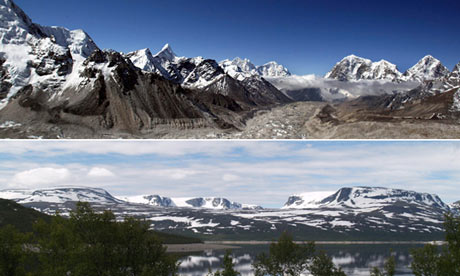Soot clouds melting Himalayan glaciers
Fumes from wood fires and from diesel engines accelerate melting, Indian scientists warn 
By Randeep Ramesh and Suzanne Goldenberg, The Observer, Sunday 4 October 2009 Glaciers in the Himalayas and the Tibetan plateau that feed the river systems of almost half the world’s people are melting faster because of the effects of clouds of soot from diesel fumes and wood fires, according to scientists in India and China. The results, to be announced this month in Kashmir, show for the first time that clouds of soot – made up of tiny particles of “black carbon” emitted from old diesel engines and from cooking with wood, crop waste or cow dung – are “unequivocally having an impact on glacial melting” in the Himalayas. Scientists say that, while the threat of carbon dioxide to global warming has been accepted, soot from developing countries is a largely unappreciated cause of rising temperatures. Once the black carbon lands on glaciers, it absorbs sunlight that would otherwise be reflected by the snow, leading to melting. “This is a huge problem which we are ignoring,” said Professor Syed Hasnain of the Energy and Resources Institute (Teri) in Delhi. “We are finding concentrations of black carbon in the Himalayas in what are supposed to be pristine, untouched environments.” The institute has set up two sensors in the Himalayas, one on the Kholai glacier that sits on the mountain range’s western flank in Kashmir and the other flowing through the eastern reaches in Sikkim. Glaciers in this region feed most of the major rivers in Asia. The short-term result of substantial melting is severe flooding downstream. Hasnain says India and China produce about a third of the world’s black carbon, and both countries have been slow to act. “India is the worst. At least in China the state has moved to measure the problem. In Delhi no government agency has put any sensors on the ground. [Teri] is doing it by ourselves.” In August this year Yao Tandong, director of China’s Institute of Tibetan Plateau Research, projected “a 43% decrease in glacial area by 2070”, adding that “more and more scientists have come to recognise the impact of black carbon in glacial melting”. …
Soot clouds pose threat to Himalayan glaciers